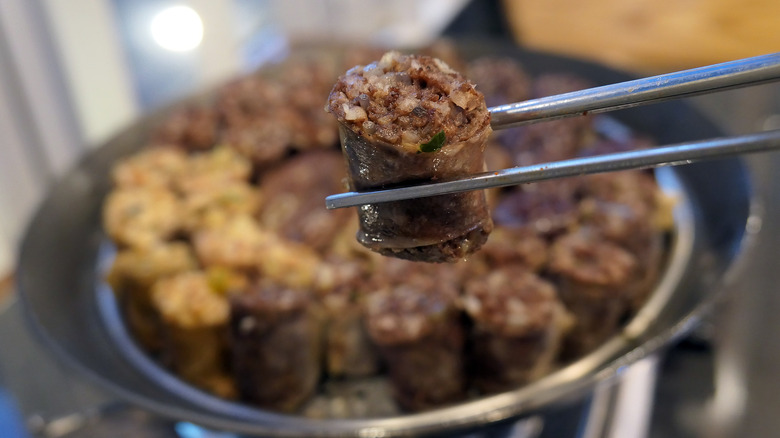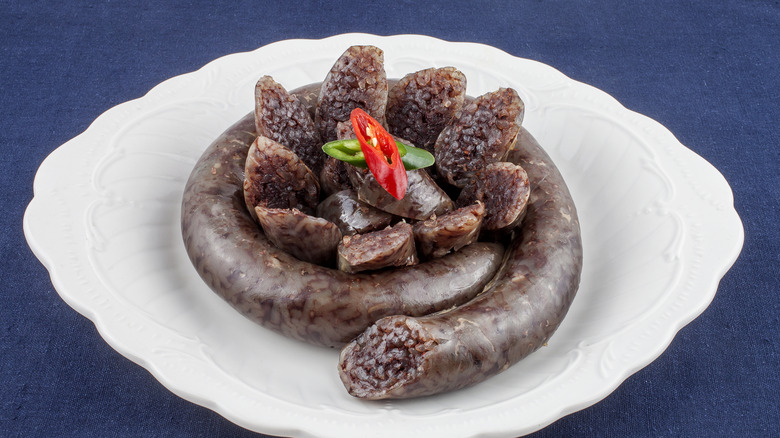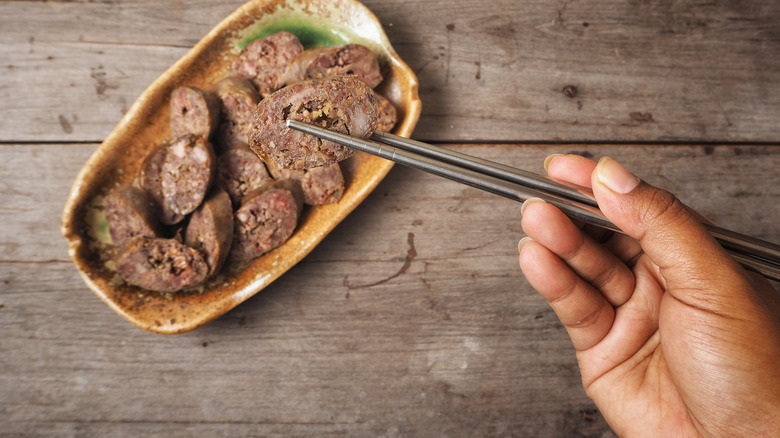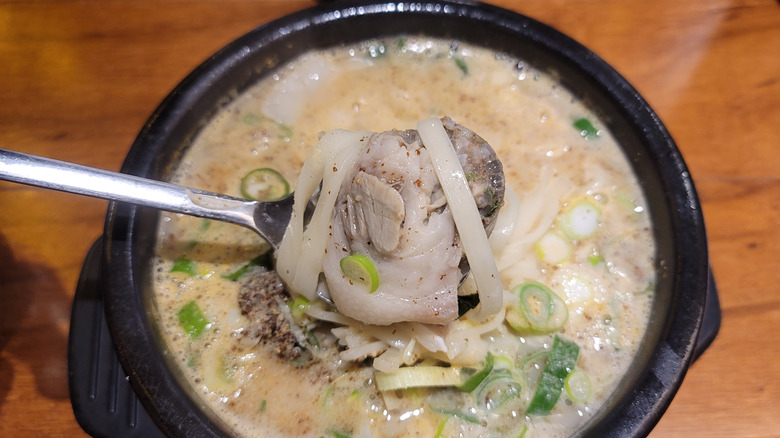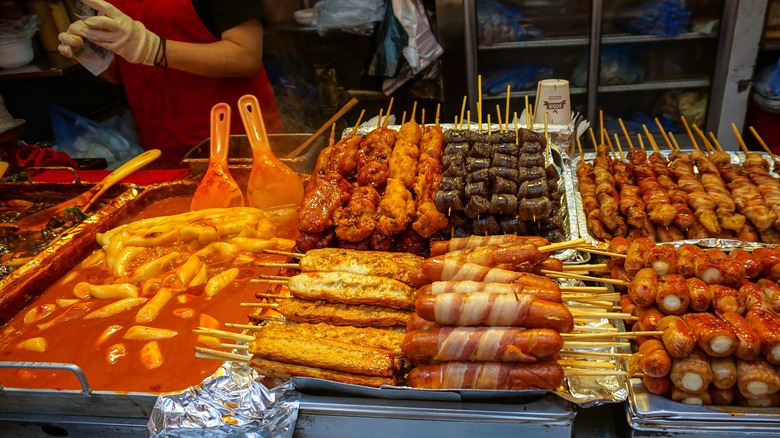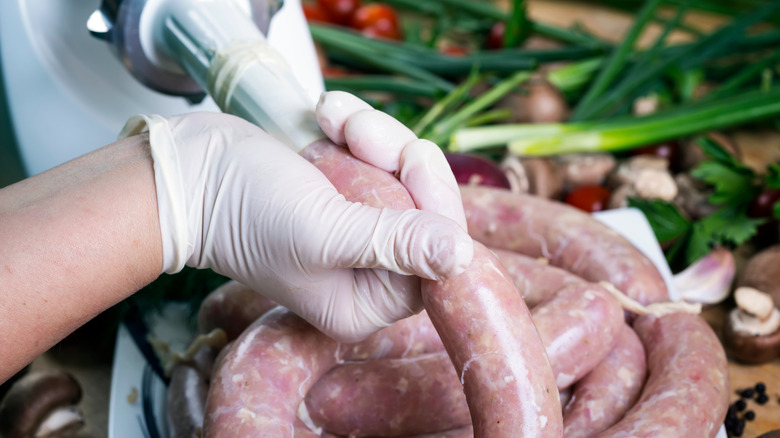Soondae: The Korean Blood Sausage You Should Know About
When people think of Korean food, savory barbecue or crunchy fried chicken may first come to mind. Or perhaps, the spicier quintessential Korean food kimchi or the equally spicy gochujang paste are pictured. Although not as well-known among Westerners, a popular street food in South Korea is soondae, a blood sausage similar to Western blood sausage, according to Korean Food Stuffs, such as Germany's blutwurst. Also spelled sundae in English, the blood sausage couldn't be further in taste and texture from the ice cream treat.
People walking along the streets of Seoul or other large South Korean cities like Busan and Daegu will find street vendors selling sausage, per Korean Food Stuffs, which is often eaten as a snack, especially during a night of drinking soju with friends or co-workers. Koreans also enjoy some other Western-influenced sausages, such as "pink sausage" or boon-hong sausages, according to Future Dish. Boon-hong sausage is made from pork, corn starch, and flour and became popular in the 1970s as a component of school lunches when fresh meat was too expensive.
Nowadays with the South Korean economy doing much better, fresh meat is back on the menu, and so is soondae.
What is soondae?
Most commonly, soondae is made of pork blood, glass noodles (dangmyeon or vermicelli can be used), and glutinous rice, according to Serious Eats, giving the sausage a solid and chewy texture. Korean Food Stuffs says that cow intestines and squid are often used in making soondae and that it may also contain pork liver, lungs, or stomachs.
Serious Eats compares soondae's texture to that of mochi, which is a Korean and Japanese treat made of sweet glutinous rice flour, according to All Recipes. In addition to the main ingredients, soondae is seasoned with sugar, salt, chili powder, sesame seeds, and ground-dried shrimp, according to Serious Eats. The natural casing for soondae is generally from a cow or pig, per The Korean Guide. To cook it, soondae is most often steamed, according to The Korean Guide. However, if it has been precooked, it can be eaten hot or cold, making it a quick snack.
What does soondae taste like?
While the thought of eating sausage made with pig blood sounds like it would have a strong taste, Serious Eats says that's not the case. While the flavor of soondae is mild, according to Serious Eats, the blood incorporated into the sausage can be tasted. A lot of the taste found in soondae is in the spices and seasonings that are added to it, per The Korean Guide, because it does not have a strong taste without it. To enhance the flavor, ground-dried shrimp can be added to the sausage.
Giving soondae a flavor boost in a recipe provided by Travel Food Atlas that calls for garlic, ginger, pepper, Korean toasted sesame oil, sesame seeds, and scallions for the filling. While sausages can be heavy, The Red Cellar describes soondae as having a springy consistency because of the sticky rice in the filling. In fact, The Red Cellar says the taste and texture can make soondae irresistable.
How is soondae served?
Soondae can be found served in several ways, but it often comes sliced with a side of salt and chili flake mixture for dipping (via The Red Cellar). Other options include sprinkling the sausage with the Japanese shichimi togarashi, which is a spice mixture, or chili sambal, which is comparable to a chili sauce.
In South Korea's second-largest city, Busan, soondae is served with green chili and ssamjang sauce, made of fermented soybeans, red chili paste, sesame oil, onion, garlic, and green onions, according to Luca-Sartor. Another popular way for soondae to be served is for it to incorporate into a soup or guk. A recipe for Korean Blood Sausage Soup (SunDaeGuk) on Aeri's Kitchen includes a savory broth of ox bone broth, salted shrimp, chives, onions, and more. Others opt to make a dynamic stir fry, called soondae bokkeum. A recipe on The Korean Guide for soondae bokkeum includes glass noodles, enoki mushrooms, garlic, sesame seed powder, soju, mirin, or rice wine, red pepper flakes, gochujang, rice vinegar, brown sugar, cabbage, Thai chiles, and more.
When is soondae eaten?
Soondae is eaten in both North Korea and South Korea, according to The Korean Guide, where it is sold in stores, by street vendors, and is made in homes. The Korean sausage isn't usually eaten as a meal, but as a snack or side dish, per The Korean Guide, perhaps with a glass of soju during a night out with friends in Seoul. The vendors that sell soondae, often fill their booths with other foods. In particular, it's often sold at the same vendor stalls that dish out the fiery red tteokbokki (rice cakes in a spicy sauce), per Korean Food Stuffs.
Originally when soondae was first made during the Goryeo period (918 to 1392), the sausage was eaten during festivals and holidays, according to Travel Food Atlas. During the period, soondae was typically made with abundant wild boar, per The Korean Guide. Although most commonly believed to have originated during the Goryeo period, Korean Food Stuffs contends that the sausage's origins may lie in 6th century China when vegetables were added to the intestines of cows and then steamed. The blood sausage was also made for birthdays during its early days, per Korean Food Stuffs.
Some of the earliest recipes for soondae can be found in 19th-century cookbooks. When meat became less available after the Korean War (1950 to 1953), soondae underwent a significant change and glass noodles, called dangmyeon in Korean, were used in the place of meat, per Travel Food Atlas.
How to make soondae
Soondae is best eaten fresh, according to Serious Eats, because when it has been refrigerated, the texture changes making it stiffer. Generally, soondae is steamed (via The Korean Guide).
The Korean Guide highlights that soondae is fast food to make, whether it was pre-packaged or you make it fresh. It should take about 10 minutes to reheat leftover soondae or to cook pre-packaged soondae. To make the blood sausage from scratch, The Korean Guide says it will take closer to 35 minutes to make. The recipe on The Red Cellar calls for the freshly made sausages to be cooked in simmering water, but not boiling, to avoid the sausages from bursting in the water. Another tip to prevent the sausages from splitting? Take a toothpick and put five to six holes in each sausage to release air while they cook. After the sausages have been removed from the water, they should be left to rest so the mixture doesn't leak out of the casings.
If soondae has been refrigerated and lost its soft texture, you can restore some of that by adding it to a soup or stew, according to Serious Eats. Another technique for making the chilled soondae more appetizing is by pan frying it in order to give the sausage a crispy exterior and a soft interior, but make sure not to cook the sausage over too high of heat.
What variations of soondae are there?
Like many recipes, soondae's ingredients can be adapted to where it is being made. There are regional variations of soondae that can include squid, barley, fermented soybean paste, and soybean sprouts, as well as the ubiquitous kimchi or the flavorful perilla leaves, according to Serious Eats. Easy Korean Food lists myeong tae sundae (pollock) and ojingeo sundae (squid and noodles sausage) as two other popular versions. The Korean Guide says that the bladders of brown croakers, a type of fish, have been known to be used soondae.
There are even vegetarian versions of the sausage created, writes The Korean Guide, that are made by Buddhist monasteries and restaurants. And just like there are different ingredients used to make kimchi in North Korea compared to South Korea, so is true for soondae, per The Korean Guide.
With the increasing popularity of Korean foods around the world, could soondae be the next big thing?
